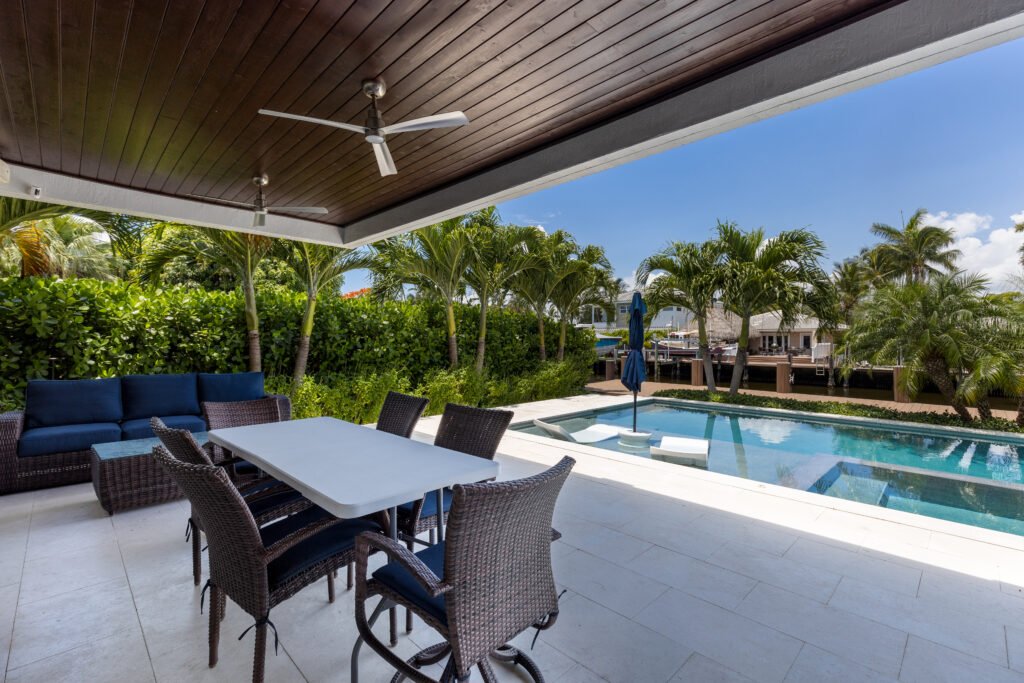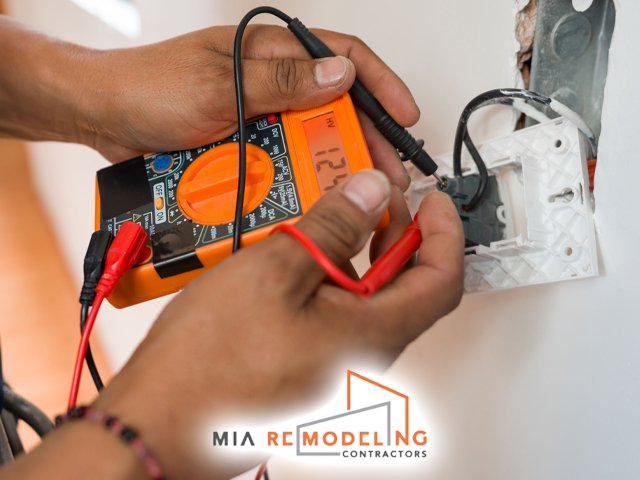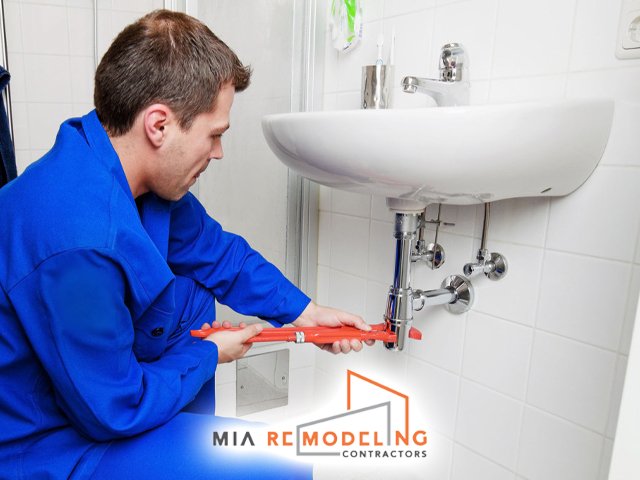Insulated roof panels use a foam core to block heat from the sun, keep the patio ceiling cool, and shed rain water. The panels reduce heat transfer, so your home’s AC does not work as hard. The result is a patio that feels calm on hot afternoons and a home that spends less energy. Plus, you get solid rain cover in one upgrade.
Why insulated roof panels are a smart patio move
Miami Beach sun is no joke. On a clear day, your patio roof can feel like a skillet. Insulated roof panels step in like a cool hat. Each panel is a sandwich. Metal on top, foam in the middle, metal on bottom. That foam core slows heat. The top skin takes the sun. The foam blocks most of the heat from moving down. The bottom skin stays cooler, so you feel better sitting under it.
Add gutters and a tight fit, and you get a patio that drains rain the right way. You can sip coffee while a shower passes. No wet mess dripping through. No damp cushions. Less glare. Less sweat. More time outside.

How foam cores cut heat
Think of heat like a car trying to rush through traffic. The foam core is a traffic jam. It slows the heat cars to a crawl. Fewer cars get through. Your patio stays cooler.
Here is what is going on inside a panel:
- The sun blasts the top metal skin.
- The foam core blocks heat flow by conduction.
- The white or light top skin reflects a lot of the sun.
- The air below the roof does not warm up as fast.
- Your AC does not battle patio heat that used to leak into the house through doors and sliders.
Thicker foam means more blocking. Many patios use panels from a few inches thick to thicker builds. More thickness means more comfort and less heat gain. A light color top helps even more.
What it means for your electric bill
When the patio is cool, the wall and doors behind it stay cooler too. That cuts heat load inside. The AC cycles a bit less. Small changes add up in Miami Beach. That drop can be real in late afternoons when the sun hits the back of the house. Less run time, less energy. You feel it in comfort first, then on the bill.
Rain and storm protection in one move
We get pop-up showers and long soakers. We also get wind and sideways rain. Insulated roof panels lock together with tight joints. Water channels into integrated gutters, then out downspouts. The ceiling below stays dry. You can grill, read, or watch a game outside while rain taps the top like drum beats.
During windy days, a strong patio roof is a must. A pro can size the panels and fasteners to meet local wind codes. The right anchors keep panels from lifting. Proper sealants keep joints tight. You get solid cover that stands up to storm season.
Miami Beach weather and salt air
Heat, humidity, and salt float in off Biscayne Bay and the ocean. That mix can wear on lower-grade steel and less durable coatings. Most insulated patio panels use aluminum skins. Aluminum does well in salty air when coated right. With cleanings and checks, your roof stays sharp.
Humidity is a sneaky player. A cool roof with warmer air below can sweat if venting is poor. Good design keeps air moving and joints sealed. That stops drips from condensation. A smooth ceiling skin also wipes clean fast when sea spray lands.
What insulated roof panels are made of
- Skins: Usually aluminum. It resists rust and stays light. A baked finish keeps color.
- Core: Foam. Common types are rigid foams made for buildings. They block heat and add stiffness.
- Joints: Tongue and groove or locking seams. These keep the lid tight and help with wind.
- Flashings and gutters: Trim parts that keep water out and move it away from the house.
Why this works well in Miami Beach backyards
- Shade that cools right away
- Less glare on pool water and glass doors
- Dry space for grills, TVs, and kids gear
- Less strain on indoor AC units
- Better use of patios year round
Real talk from the patio
You might ask, Does it feel cooler right away? Yes. Step under an insulated roof at noon and you will feel the difference in seconds. You also might ask, Will it hold up in storms? With the right build and anchors, yes. We match parts to local wind needs and roof tie-ins.
A short backyard story
A homeowner off Alton Road wanted to watch games outside on Sundays. The old patio cover was thin metal. It felt like sitting in a toaster. We swapped in insulated panels with a white top. The glare went down. The TV looked clear. Afternoon heat felt tame. He laughed and said, “My patio went from broiler to breezy in a day.”
Design choices that boost comfort
- Color: A white top reflects sun well. Light gray also works.
- Thickness: Thicker foam blocks more heat. Pick based on sun and patio size.
- Ceiling finish: Smooth and bright helps with light bounce without glare.
- Fans: Add a ceiling fan for air flow. Even a slow spin helps.
- Layout: Extend the roof so sun does not sneak in low on the sides. An extra foot can matter at 5 pm.
Sound and rain vibe
Rain on a metal top can sound nice. Like a camping tent, but calmer. The foam core softens the ping. You get a gentle rhythm instead of a racket. On hot days, you still sit and chat without raising your voice.
Where insulated roof panels fit best
- Ground patios behind condos or homes off Collins Avenue
- Pool decks in North Beach where sun reflects off water
- Townhomes near Normandy Isles with small yards and tight lines
- Side yards where you want shade but keep light in windows
What we usually see in Miami Beach, FL
- Strong afternoon sun from the west on back patios
- Salt film on top skins near the water after windy days
- Fast gutter clogs from palm fronds if no leaf guards
- Patio TVs and grills that need dry space and cool air
Basic install steps a pro follows
- Measure the patio pad and check the home wall for tie-in height
- Set posts and ledger, then add beams based on span
- Lay panels, lock seams, seal joints
- Add gutters and downspouts
- Wire fans or lights by a licensed electrician
- Flash roof edges to keep water out of the wall
- Final check for pitch, drainage, and tight fasteners
Safety notes
- Do not stand on a panel unless it is built for foot traffic and you know where to step
- Electrical work needs a licensed pro
- Permits may be required in Miami Beach, check before work starts
- Wear eye and hand protection when cleaning or checking gutters
How insulated panels reduce heat transfer
Heat tries three moves. It conducts through solids, it convects with air, and it radiates like sun energy. The foam core blocks conduction. The tight seams and ceiling fan cut convection. The bright top skin reflects a lot of radiant heat. Three moves, three blocks. That is why you feel the change.
Electric bill tips that pair well with your new roof
- Weather strip the sliding door near the patio
- Use light colored patio rugs and furniture to cut heat
- Add a fan and set it to a low speed for steady air
- Keep the patio door closed on hot days to stop heat creep
- Use smart shades inside on the patio side of the house
Rain management done right
Pitch matters. A small slope moves water without making the roof look odd. Gutters catch flow. Downspouts drain to a safe spot, not onto walkways. Leaf guards save time if you have palms or seagrape trees. Ask for splash blocks at the ground to stop erosion.
Noise from the street
Near Collins Avenue you may hear traffic rush. Insulated panels help dampen top noise during rain. Add a privacy wall or plants on the sides and it can feel like a small outdoor room.
Troubleshooting steps
- If the ceiling drips on clear days, then check for condensation and add a fan or edge vent
- If rain leaks at a seam, then clean the joint and reseal with the correct sealant
- If you see chalking on the top skin, then wash gently with mild soap and water
- If gutters overflow, then clear debris and confirm the roof pitch is correct
- If fasteners show rust, then replace with the correct grade and seal the holes
- If the roof feels too short in late sun, then add a side shade or extend the overhang
- If you hear panel creaks, then check for loose screws and tighten to spec
Common myths and facts
- Myth: A solid patio roof makes the house darker. Fact: A light ceiling reflects soft light back. Plan window shades and fan lights and you are fine.
- Myth: Foam roofs trap heat. Fact: The foam blocks heat from entering. Air below stays cooler with a fan and open sides.
- Myth: Panels cannot handle Miami wind. Fact: With correct fasteners, spans, and tie-ins, they meet local wind needs.
- Myth: All foam is the same. Fact: Quality, thickness, and skins matter. Lower-quality parts in salt air age faster.
Care schedule
- Weekly: Quick sweep of leaves on top if you can reach with a safe pole. Wipe spills on the ceiling skin.
- Monthly: Rinse the top with a hose from the ground. Check gutters for fronds. Look at downspout flow on a rainy day.
- Yearly: Full wash of the top skins with a soft brush and mild soap. Inspect sealant lines and fasteners. Touch up paint on trims if needed. Check the fan and light mounts.
Choosing the right thickness and span
Longer spans need thicker panels or extra beams. A pro will match panel thickness to the distance between supports. The goal is a roof that does not flex, even when someone must step on it for maintenance. Let design follow the load and the wind needs.
Light kits and fans
Ceiling fans make patios feel cooler by moving air across your skin. Even a slow speed helps a lot. Use outdoor rated fans. Seal wire holes tight. Add LED lights in the fan or as strips tucked behind a small valance for soft glow.
Finishes and color care
Go light on the top to reflect sun. White, ivory, or pale gray do well. The bottom can be white or a soft tone that fits your home. Avoid dark tops. Dark colors soak heat and can cook the roof. In salt areas, rinse more often. That keeps the finish clean and bright.
Permits and local code notes
Miami Beach follows the Florida Building Code. Patio roofs need the right anchors, posts, and tie-ins. Wind uplifts matter. A pro pulls the right permit and schedules inspections. This keeps your home safe and helps with insurance. Keep your plans and approvals on file.
How long do insulated roofs last
With good parts and care, these roofs can serve for many years. Salt and sun are the big tests. Regular rinsing, clean gutters, and sealed joints make a big difference. If you live closer to the water, add one or two extra cleanings a year.
Shade strategy that works with the sun path
Think about where the sun drops in late day. In Miami Beach, west and southwest sun can sneak under a roof. A longer overhang helps. Side curtains or a pergola screen can block low sun while keeping air flow. Plan for winter sun at a lower angle so you still get light when days are cooler.
What to expect on install day
A crew shows up with posts, beams, panels, and trims. They set the ledger on the house. Posts go into footings or anchors. Beams connect. Panels slide in and lock. Joints get sealed. Gutters hook up. Fans get wired. Then a clean up. Your patio goes from hot plate to hangout fast.
A quick chat you might have with a pro
You: Will I need extra support for a TV under the roof
Pro: Yes, we add a backer plate at the right spot so the mount is solid.
You: Can we add a skylight
Pro: We can use a clear panel bay, but let us place it so heat and glare stay low.
You: How about a grill
Pro: Keep open air around it and follow clearances. Heat and smoke need space.
Add ons that play nice
- Side shades on tracks for wind and sun control
- Screen walls to keep bugs out when the breeze dies
- Heater for cooler winter nights when a front rolls through
- Smart dimmers for lights to set the mood for game night
Why not just use a simple metal sheet roof
Single-sheet metal without foam warms quickly, radiates more heat downward, can be noisier in rain, and may show more condensation in humid conditions. An insulated panel is designed to be strong, quiet, and cool for long-term comfort.
Humidity tips to stop sweating ceilings
If you notice drops on the ceiling on sticky mornings, add a fan. Keep air moving. Check that your patio is not sealed tight on all sides. Some air in and out is good. If you have a pool, try to keep splashes off the ceiling to reduce water vapor right under the roof.
Drainage and splash zones
Downspouts should drop on a splash block or into a drain line. Do not let water wash out sand near pavers. If you are near a pool, aim outlets away from the deck to avoid puddles. Check flow during a storm to see if the slope and gutter size handle heavy rain.
Working around Miami Beach quirks
Small lots, strict set backs, and old masonry walls can shape your patio plan. A slim beam and the right panel span help keep posts spaced wide so you have more open room. We have seen older stucco that needs a new ledger strip to make a clean tie-in. A quick fix there pays off in a neat finish.
Eco notes
An insulated roof makes shade that lowers heat gain. That helps the house use less energy. Some panels use coatings that reflect more sun. Pair the roof with native plants and you get a cooler yard too.
FAQs
Q: What are insulated roof panels for patios
A: They are roof sections with a foam core between metal skins. They block heat, shed rain, and make a cool, dry patio.
Q: How do they cut my electric bill
A: The patio behind your house stays cooler, so doors and walls take in less heat. Your AC runs less, so you save energy.
Q: Will this stand up to Miami Beach wind and rain
A: With the right parts, anchors, and permits, yes. We match spans and fasteners to local code and wind needs.
Q: Do I need a permit in Miami Beach
A: Most patio roofs need a permit. A pro can handle plans and inspections so the job meets code.
Q: Can I add lights and a fan
A: Yes. Use outdoor rated fixtures. Have a licensed electrician wire them. Seal all holes to keep the roof tight.
Q: How thick should the panels be
A: Thicker panels block more heat and handle longer spans. A pro will size them based on your patio and sun.
Q: How do I clean the roof
A: Rinse with a hose, use mild soap, and a soft brush. Keep gutters clear. Avoid harsh cleaners that can dull the finish.
Q: Will the roof make my house too dark
A: A light ceiling reflects soft light. Pair with good indoor shades and a fan light and your space will still feel bright.
Q: Can I walk on the roof
A: Only if the panels and support allow it and you know where to step. Ask your installer first to be safe.
Q: How long does install take
A: Many patios go up in a short window once permits are in hand. The crew builds fast with panel systems.
Closing thoughts you can use today
Insulated roof panels make patios feel like a fresh room outside. Foam cores block heat. The roof sheds rain. Fans and lights add comfort. Your AC breathes easier. You get more living space without moving walls. In a sunny place like Miami Beach, that is a big win.
If you want a patio that stays cool and dry, Mia Remodeling Contractors is ready to help. We plan, permit, and build insulated patio roofs that fit Miami Beach homes and weather. Call <tel:+1-954-355-1520>(954) 355-1520</tel:+1-954-355-1520> or visit https://miaremodelingcontractors.com/ to schedule your project and enjoy a cooler patio all year.




